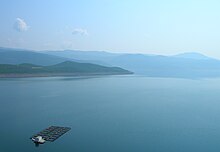Bileća
|
Bileća Билећа |
||
|
|
||
| Basic data | ||
|---|---|---|
| State : | Bosnia and Herzegovina | |
| Entity : | Republika Srpska | |
| Coordinates : | 42 ° 52 ' N , 18 ° 25' E | |
| Height : | 476 m. i. J. | |
| Area : | 633 km² | |
| Residents : | 10,201 (2018) | |
| Population density : | 16 inhabitants per km² | |
| Telephone code : | +387 (0) 59 | |
| Postal code : | 89230 | |
| Structure and administration (as of 2016) | ||
| Mayor : | Miljan Aleksić ( SNSD ) | |
| Website : | ||
Bileća ( Serbian - Cyrillic Билећа ) (German obsolete Bilotscha or Boletsch ) is a town and municipality in the southeast of Bosnia and Herzegovina near the border with Montenegro . It is part of the Republika Srpska .
history

Bileća was first mentioned in 1286.
In the Battle of Bileća on August 27, 1388, the Bosnian army of King Tvrtko I was victorious over an Ottoman force .
During the Bosnian War , the region was largely spared from fighting. However, a large part of the non-Serbian population was displaced.
geography
The city is located in the east of Herzegovina at an altitude of 486 m in the immediate vicinity of the Montenegrin border. South of the city, on the upper reaches of the Trebišnjica , is the lake Bilećko jezero , which was dammed up from 1966 .
Neighboring municipalities are Berkovići , Gacko , Ljubinje , Nevesinje and Trebinje and Nikšić in Montenegro.
population
At the 1991 census, the municipality of Bileća had 13,284 inhabitants, including
- Serbs : 10,628 (80.00%)
- Bosniaks : 1,947 (14.66%)
- Yugoslavs : 222 (1.67%)
- Croatians : 39 (0.29%)
- Others: 448 (3.37%)
7,568 people lived in the main town, including
- Serbs : 5,619 (74.25%)
- Bosniaks : 1,290 (17.05%)
- Yugoslavs : 209 (2.76%)
- Croatians : 39 (0.52%)
- Others: 411 (5.43%)
The proportion of Serbs is even higher after the Bosnian war than before.
The municipality comprises a total of 61 places: Baljci, Bijela Rudina, Bijeljani, Bileća, Bodenik, Bogdašići, Brestice, Čepelica, Deleuša, Divin, Dječe, Dlakoše, Dola, Donja Meka Gruda, Donji Davidovići, Fatnica, Golobrđe, Gornja Mekka Davidovići, Granica, Hodžići, Kačanj, Kalac, Korita, Krivača, Krstače, Kukričje, Kuti, Lađevići, Milavići, Mirilovići, Miruše, Mrežica, Narat, Njeganovići, Oblo Brdo, Orah, Podjeana, Orahovice, Pagor , Preraca, Prijevor, Prisoje, Rioca, Selišta, Simijova, Skrobotno, Šobadine, Todorići, Torić, Trnovica, Vlahinja, Vranjska, Vrbica, Zasada, Zaušje, Zvijerina and Žudojevići.
Eight of these places had a predominantly Bosniak population.
economy
Before the war, the city was dominated by textile, metal and food industries, which, however, have not yet recovered from the collapse of the socialist economic system and the interruption of trade relations during the war years.
In the villages that are difficult to access, subsistence agriculture continues to play a major role. The military training area on the outskirts is also important.
traffic
Bileća is located on the M20 main road (Trebinje – Foča), which serves as a cross-regional connection between Dubrovnik and Belgrade or Sarajevo .
sons and daughters of the town
- Ervin Eleskovic (* 1987), Swedish tennis player
Web links
- Portal page bileca.org
- Portal page bilecainfo.com
- Bileća on the website of the Federal Commissioner for Bosnia and Herzegovina (1998) ( Memento from September 16, 2008 in the Internet Archive )
Individual evidence
- ↑ http://rzs.rs.ba/front/article/3630/ Updated population figures for 2018 from the Institute for Statistics of the Republika Srpska. Retrieved June 9, 2019.





